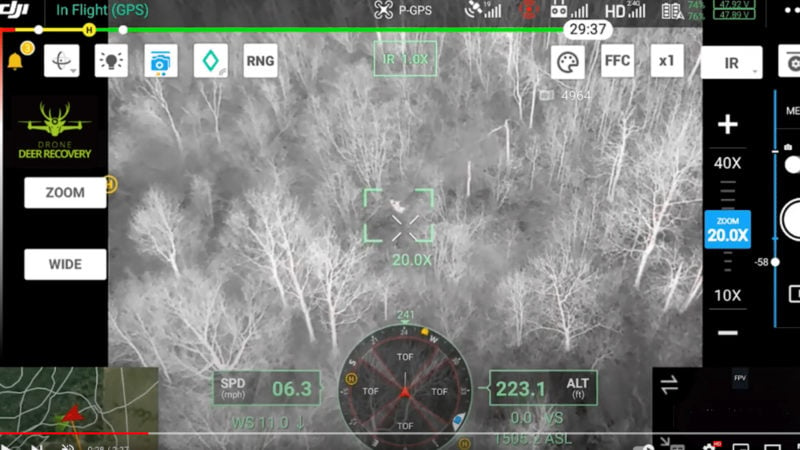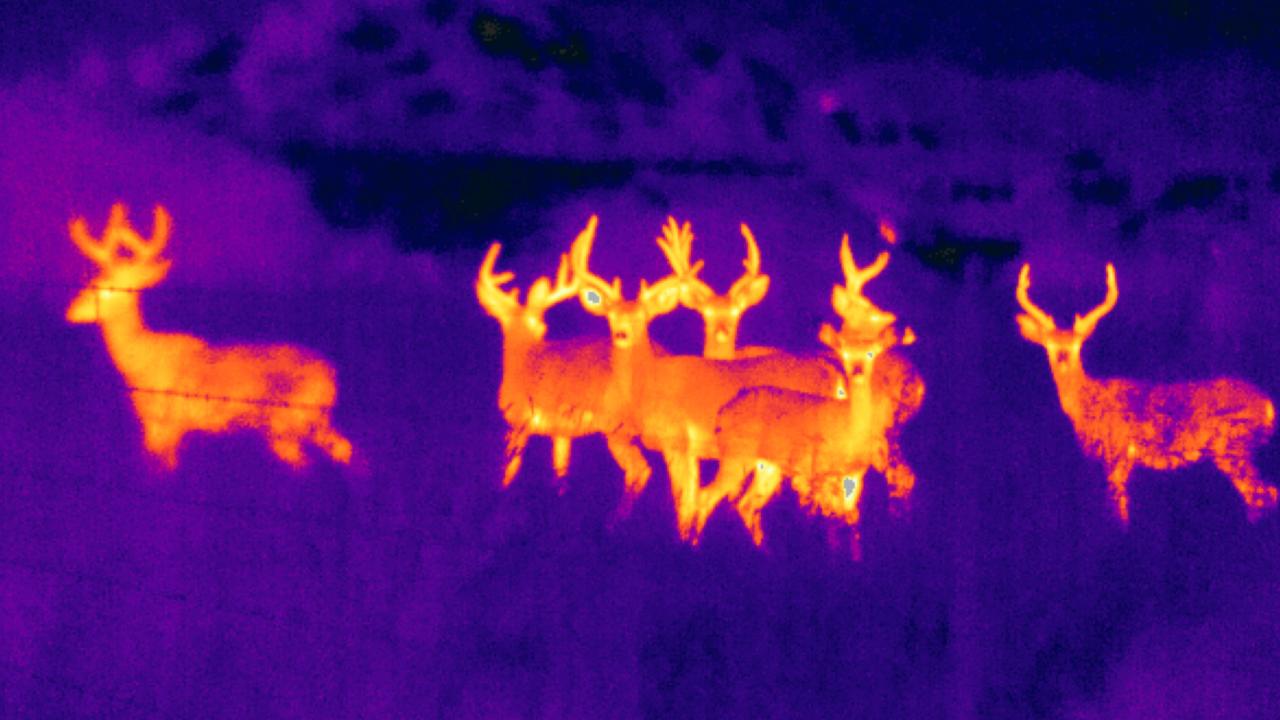Thermal imaging for deer recovery is revolutionizing the way hunters track and retrieve downed game. By harnessing the power of infrared technology, hunters can now locate deer with precision, even in challenging conditions. This technology offers numerous advantages, transforming the deer recovery process into a more efficient and successful endeavor.
From understanding the principles behind thermal imaging to mastering field techniques, this comprehensive guide will equip you with the knowledge and skills necessary to effectively utilize thermal imaging for deer recovery. By embracing this innovative technology, you’ll elevate your hunting experience and increase your chances of a successful recovery.
Thermal Imaging Technology: Thermal Imaging For Deer Recovery
Thermal imaging is a technology that allows users to see heat signatures. This can be useful for a variety of purposes, including deer recovery. When a deer is shot, it will often leave a heat signature that can be detected by a thermal imaging camera.
Thermal imaging cameras work by detecting infrared radiation. Infrared radiation is a type of electromagnetic radiation that is emitted by all objects with a temperature above absolute zero. The hotter an object is, the more infrared radiation it emits.
When a thermal imaging camera detects infrared radiation, it converts it into an image. The image shows the temperature of the objects in the scene. Warmer objects appear brighter than cooler objects.
Advantages of Using Thermal Imaging for Deer Recovery
- Thermal imaging can be used to detect deer that are hiding in thick vegetation.
- Thermal imaging can be used to track deer that are moving through the woods.
- Thermal imaging can be used to find deer that have been shot and are lying down.
Limitations of Using Thermal Imaging for Deer Recovery
- Thermal imaging is not effective in all weather conditions. It is most effective in cold weather when there is a large temperature difference between the deer and its surroundings.
- Thermal imaging can be expensive.
Examples of How Thermal Imaging Has Been Successfully Used in Deer Recovery Efforts
- In one case, a hunter used a thermal imaging camera to find a deer that had been shot and was lying down in a thick thicket. The hunter was able to track the deer and recover it.
- In another case, a group of hunters used a thermal imaging camera to track a deer that was moving through the woods. The hunters were able to follow the deer and eventually shoot it.
Equipment and Setup

Proper equipment and setup are crucial for successful deer recovery using thermal imaging. This section will guide you through the types of equipment available, the setup process, and the ideal environmental conditions for optimal performance.
Types of Thermal Imaging Equipment
- Handheld Thermal Imagers:Compact and portable, suitable for quick scans and locating deer in close range.
- Rifle-Mounted Thermal Imagers:Attach to riflescopes, providing a clear view of the target area while aiming.
- Drone-Mounted Thermal Imagers:Mounted on drones, offering a wide field of view and the ability to cover large areas.
Setup and Calibration
Before using thermal imaging equipment, proper setup and calibration are essential. Follow these steps:
- Mount the Equipment:Securely mount the thermal imager on the appropriate device (rifle, tripod, or drone).
- Adjust Settings:Adjust the image settings, such as brightness, contrast, and color palette, to optimize visibility.
- Calibrate the Imager:Use a calibration source (e.g., a blackbody) to ensure accurate temperature readings.
Optimal Environmental Conditions
Environmental conditions can affect the effectiveness of thermal imaging. Optimal conditions include:
- Low Ambient Temperature:Thermal imaging detects temperature differences, so colder temperatures make it easier to distinguish deer from the surroundings.
- Clear Visibility:Fog, rain, or heavy vegetation can obstruct thermal imaging signals.
- Windless Conditions:Wind can create temperature fluctuations that can interfere with thermal imaging accuracy.
Field Techniques

Deer recovery with thermal imaging involves scanning the area with a thermal imaging device, which detects and displays infrared radiation emitted by objects in the environment. The warmer an object is, the more infrared radiation it emits, making it appear brighter on the thermal image.
Thermal imaging is a valuable tool for deer recovery, especially at night or in low-light conditions. While thermal imaging can detect the heat signature of any deer, it is particularly effective for recovering black deer. Black deer are relatively rare, but they are found in certain areas of Tennessee.
Their dark coloration makes them difficult to spot in the woods, but thermal imaging can easily identify their heat signature. This makes thermal imaging an essential tool for hunters who want to recover their deer quickly and efficiently.
Deer have a higher body temperature than their surroundings, making them easier to spot using thermal imaging.When using thermal imaging for deer recovery, it is important to be aware of the limitations of the technology. Thermal imaging can be affected by factors such as the weather, the terrain, and the distance to the target.
It is also important to be able to interpret thermal images correctly in order to identify deer and distinguish them from other animals.
Interpreting Thermal Images
Thermal images can be difficult to interpret, especially for beginners. However, with practice, it is possible to learn to identify deer and distinguish them from other animals.Deer typically appear as bright, warm objects on thermal images. They have a distinctive body shape that is easy to recognize.
The head is usually the warmest part of the deer’s body, followed by the body and the legs.Other animals, such as coyotes and raccoons, can also appear as bright, warm objects on thermal images. However, these animals typically have a different body shape than deer.
Coyotes have a long, narrow body with a bushy tail. Raccoons have a round body with a distinctive black mask around their eyes.
Tips and Tricks, Thermal imaging for deer recovery
Here are a few tips and tricks for effectively using thermal imaging for deer recovery:
- Use a thermal imaging device with a high resolution. This will help you to see more detail in the images and make it easier to identify deer.
- Scan the area slowly and carefully. This will give you time to spot deer and other animals that may be hiding in the vegetation.
- Pay attention to the movement of objects on the thermal image. Deer will often move their heads or ears, which can help you to identify them.
- Be aware of the limitations of thermal imaging. Thermal imaging can be affected by factors such as the weather, the terrain, and the distance to the target.
Ethical Considerations

The use of thermal imaging for deer recovery raises ethical concerns that must be addressed to ensure responsible and sustainable hunting practices. It’s crucial to consider the potential impact on wildlife and the integrity of the hunting experience.
Thermal imaging is a valuable tool for deer recovery, allowing hunters to locate downed animals quickly and efficiently. However, deer have a keen sense of smell, and their natural fragrance can make them difficult to track. Understanding the fragrance from deer can help hunters avoid spooking animals and increase their chances of a successful recovery.
Thermal imaging can then be used to pinpoint the location of the downed deer, minimizing the time spent searching and reducing the risk of spoilage.
Minimizing Disturbance to Wildlife
- Use thermal imaging only when necessary for recovery purposes.
- Avoid prolonged or excessive use, which can disrupt natural behaviors and cause stress to deer.
- Minimize noise and movement to avoid spooking deer and altering their patterns.
Impact on Deer Populations
Concerns have been raised about the potential impact of thermal imaging on deer populations. However, studies have shown that when used responsibly, thermal imaging does not significantly affect deer survival rates or population dynamics.
Final Thoughts

Incorporating thermal imaging into your deer recovery strategy empowers you with an invaluable tool. Not only does it enhance your ability to locate downed game, but it also promotes ethical hunting practices by minimizing disturbance to wildlife. By understanding the technology’s capabilities and limitations, you can leverage its benefits while ensuring the well-being of deer populations.
Embrace thermal imaging and unlock the potential for a more rewarding and responsible hunting experience.
Frequently Asked Questions
How does thermal imaging work for deer recovery?
Thermal imaging detects infrared radiation emitted by objects, allowing you to visualize heat patterns. Deer have a higher body temperature than their surroundings, making them easy to identify even in low-light conditions or dense vegetation.
What are the advantages of using thermal imaging for deer recovery?
Thermal imaging offers several advantages, including increased visibility in low light, enhanced target identification, and the ability to track deer through dense cover or at longer distances.
How do I interpret thermal images to identify deer?
Deer appear as bright, heat-emitting objects on thermal images. By observing the shape, size, and movement of these objects, you can distinguish deer from other animals or objects.
Are there any ethical considerations when using thermal imaging for deer recovery?
Yes, it’s important to use thermal imaging responsibly to minimize disturbance to wildlife. Avoid shining the thermal imager directly at deer for extended periods and respect hunting regulations regarding the use of artificial light.





